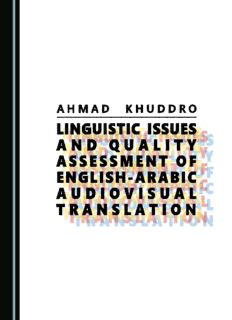
Linguistic Issues and Quality Assessment of English-Arabic Audiovisual Translation PDF
Preview Linguistic Issues and Quality Assessment of English-Arabic Audiovisual Translation
Linguistic Issues and Quality Assessment of English-Arabic Audiovisual Translation Linguistic Issues and Quality Assessment of English-Arabic Audiovisual Translation By Ahmad Khuddro Linguistic Issues and Quality Assessment of English-Arabic Audiovisual Translation By Ahmad Khuddro This book first published 2018 Cambridge Scholars Publishing Lady Stephenson Library, Newcastle upon Tyne, NE6 2PA, UK British Library Cataloguing in Publication Data A catalogue record for this book is available from the British Library Copyright © 2018 by Ahmad Khuddro All rights for this book reserved. No part of this book may be reproduced, stored in a retrieval system, or transmitted, in any form or by any means, electronic, mechanical, photocopying, recording or otherwise, without the prior permission of the copyright owner. ISBN (10): 1-5275-1318-1 ISBN (13): 978-1-5275-1318-1 Ahmad Khuddro is a former visiting professor at Bologna University, Italy; the former chair of the English and Translation Dept and currently secretary general of graduate studies council at Effat University, KSA; visiting professor at London City University, UK; and an authority on English–Arabic audiovisual translation. TABLE OF CONTENTS Chapter One ................................................................................................. 1 Introduction 1.1 Focus ................................................................................................ 1 1.2 Value and Significance .................................................................... 2 1.3 A New Perspective of Audiovisual Translation (AVT) .................. 2 1.4 Audiovisual Material Used .............................................................. 3 1.5 Outline ............................................................................................. 4 Chapter Two ................................................................................................ 7 Audiovisual Translation and Linguistic Background 2.1 Defintion of Translation................................................................... 7 2.2 Audiovisual Translation (AVT) ..................................................... 10 2.2.1 Definition ............................................................................. 10 2.2.2 Main Modes/Genres of AVT ................................................. 10 2.2.3 Features of AVT: ................................................................... 15 2.2.3a Dubbing ......................................................................... 15 2.2.3b Subtitling....................................................................... 16 2.2.4 Complexities of Subtitling as a Supporting Toolkit and Not as a Constraint ............................................................. 17 2.2.5 Multimodality and Multimediality in Audiovisuality ............ 21 2.2.6 Similarity between Drama Texts and Audiovisual Texts ...... 22 2.2.6.1 Drama Texts and Audiovisual Texts ............................. 22 2.3 Linguistic Background ................................................................... 28 2.3.1 Enkvist’s Model .................................................................... 29 2.3.1.1 Theme Dynamics .......................................................... 29 2.3.1.2 Cohesion Aspects .......................................................... 29 2.3.1.2a Contextual Cohesion ............................................. 30 2.3.1.2b Lexical Cohesion ................................................... 30 2.3.1.2c Clausal Linkage ..................................................... 30 2.3.1.2d Iconic Linkage ....................................................... 30 2.3.2 Gutwinski’s Model ................................................................ 31 2.3.2a Grammatical Cohesion ................................................... 31 2.3.2b LexicalCohesion ........................................................... 32 2.3.3 De Beaugrande and Dressler’s Model ................................... 32 2.3.4 Text Definition ...................................................................... 35 viii Table of Contents 2.3.4.1 Halliday and Hasan’s Approach to Text ....................... 36 2.3.4.1a What Text Is .......................................................... 36 2.3.4.1b Textual Situational Context ................................... 37 2.3.4.1c Textual Cultural Context ....................................... 38 2.3.4.2 De Beaugrande and Dressler’s Approach to Text ......... 38 Chapter Three ............................................................................................ 40 Text-types of AVT 3.1 Typology of Audiovisual Text ....................................................... 40 3.2 Legal Text-type in Subtitling ......................................................... 41 3.3 Medical Text-type in Subtitling ..................................................... 44 3.4 Narrative Subtitles ......................................................................... 45 3.4.1 Numbers ................................................................................ 45 3.4.2 Stills such as Signs on a Road or Wall .................................. 47 3.5 Multilingualism and Audiovisual Material .................................... 47 3.6 Dialogue in Subtitling .................................................................... 49 3.6.1 The Use of Deictics ............................................................... 49 3.6.2 Ellipsis ................................................................................... 49 3.6.3 Exophora ............................................................................... 50 3.6.4 Technical Restraints—Duration and Reading Speed ............ 50 3.7 Idiomatic and Figurative Language in Subtitling ........................... 52 3.8 Colloquial Language in Subtitling ................................................. 53 3.8.1 The Use of Phrasal Verbs ...................................................... 53 3.8.2 The Use of Negation.............................................................. 54 3.8.3 Polysemous Lexical Items ..................................................... 54 3.8.4 Register ................................................................................. 56 3.8.5 Conversion of Imperial Measurements.................................. 56 Chapter Four .............................................................................................. 58 Issues Encountered and Plausible Solutions of English–Arabic Subtitling 4.1 Introduction .................................................................................... 58 4.2 Linguistic Aspects of Subtitling ..................................................... 58 4.2.1 Othrographical Issues ............................................................ 59 4.2.1.1 Arabic Spelling Schools................................................ 59 4.2.1.2 Typographic Errors ....................................................... 61 4.2.2 Grammatical Issues ............................................................... 62 4.2.2.1 Collective Nouns .......................................................... 64 4.2.2.2 Diacritics ....................................................................... 65 4.2.2.3 Duality .......................................................................... 65 4.2.2.4 Exophora—Deictics (Pointing Words) and the Pronoun “You” ....................................................... 66 Linguistic Issues and Quality Assessment of English-Arabic ix Audiovisual Translation 4.2.2.5 Gender .......................................................................... 67 4.2.2.6 Hamzas ......................................................................... 72 4.2.2.7 Negation ........................................................................ 73 4.2.2.8 Numbers ........................................................................ 74 4.2.2.9 Plurality ........................................................................ 74 4.2.2.10 Prepositions ................................................................ 76 4.2.3 Syntactic Issues ..................................................................... 76 4.2.3.1 Passive Voice and Active Sentence .............................. 77 4.2.3.2 Sentence Structure ........................................................ 78 4.2.3.3 Subject–Predicate Agreement ....................................... 80 4.2.3.4 Subject–Verb Agreement .............................................. 81 4.2.3.5 Wh-structure ................................................................. 81 4.2.4 Lexical/Semantic Issues ........................................................ 83 4.2.4.1 Acronyms ...................................................................... 83 4.2.4.1.1 Reading Speed ........................................................... 86 4.2.4.2 Collocation .................................................................... 87 4.2.4.3 Eponyms ....................................................................... 87 4.2.4.4 Polysemy ...................................................................... 88 4.2.4.5 Superordinates/Hypronyms .......................................... 89 4.2.4.6 Transliteration/Borrowing ............................................ 90 4.2.4.7 Word Choice ................................................................. 91 4.2.5 Technical Issue—Line Splitting ............................................ 92 4.3 Conclusion ..................................................................................... 92 Chapter Five .............................................................................................. 95 Effective Strategies in Subtitling 5.1 Introduction .................................................................................... 95 5.2 Effective Strategies of Subtitling ................................................... 95 5.2.1 The Episode Wild Things ...................................................... 96 5.2.1.1 Addition ........................................................................ 96 5.2.1.2 Direct Translation ......................................................... 96 5.2.1.3 Intertextuality ................................................................ 96 5.2.1.4 Literal Translation ........................................................ 98 5.2.1.5 Shortening ..................................................................... 99 5.2.1.6 Less Wordy Translation, Less is Better ...................... 101 5.2.2 The Clip from the Film Good Morning, Vietnam ................ 102 5.2.2.1 Text, Context, Cohesive Devices, and Standards of Textuality ...................................................................... 102 (cid:3)
Description: